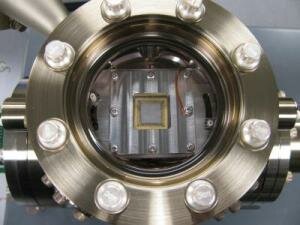Researchers Design and Test Microfabricated Planar Ion Traps
Despite a steady improvement in the speed of conventional computers during the last few decades, certain types of problems remain computationally difficult to solve.
Quantum computers hold the promise of offering a new route to solving some classes of these problems, such as breaking encryptions.
The tremendous computing power of these devices stems from their use of quantum systems, called "qubits," which can exist in a "superposition" of two states at the same time - in stark contrast to the transistors in conventional computers that can only be in the state "0" or "1."
"Though a practical quantum computer may still be decades away, research being conducted today is laying the groundwork for such a device by bridging the vast gap between the theory and practice of quantum information processing," said Dick Slusher, a principal research scientist at the Georgia Tech Research Institute (GTRI) and director of the Georgia Tech Quantum Institute.
One path toward creating quantum computers is to use trapped ions as the qubits. However, it is currently difficult to scale up conventional ion traps into an array large enough to create a useful quantum computer.
At GTRI, researchers are designing, fabricating and testing planar ion traps that can be more readily combined into large, interconnected trap arrays. Details of the research effort, led by Slusher and GTRI senior research scientist Alexa Harter, were presented at the annual meeting of the American Physical Society's Division of Atomic Molecular and Optical Physics on May 26 and 27.
The presentations were made by GTRI postdoctoral fellow Charlie Doret, GTRI research scientist Arkadas Ozakin and Georgia Tech electrical and computer engineering graduate student Fayaz Shaikh. This research is funded by the Intelligence Advanced Research Projects Activity (IARPA) and the Defense Advanced Research Projects Agency (DARPA) through contracts with the Army Research Office.
GTRI's microfabricated planar ion traps employ a combination of radio-frequency signals and static voltages applied to aluminum electrodes that are layered on silicon wafers.
"These planar trap geometries are advantageous because they are scalable to large systems of ions and also offer improved laser access compared to currently available traps," said Doret.

"Researchers at the Georgia Tech Research Institute are designing, fabricating and testing planar ion traps that can be more readily combined into large, interconnected trap arrays. (Credit: Georgia Tech/Jason Amini)"
Source: Georgia Institute of Technology Research News
|